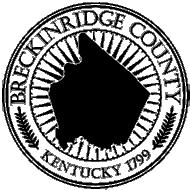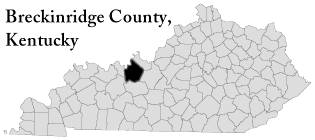 |
USGenWeb Archives Project Breckinridge County, Kentucky |
 |
 |
 |
 |
 |
USGenWeb Archives Project Breckinridge County, Kentucky |
 |
 |
 |
 |
THESE
ARCHIVES BUILT BY YOUR
CONTRIBUTIONS.
PLEASE CONTRIBUTE TODAY!
New
Easy to use Submission
Forms!
This Page Updated Monday, 11-Apr-2022 20:27:40 EDT
| BRECKINRIDGE COUNTY, KENTUCKY |
| AREA COMMUNTIES OF THE PAST AND PRESENT |
| BEWLEYVILLE |
The physical features of the landscape in the area from
old
Bewleyville to Irvington on the east side of Sinking Creek is a
thing of
natural beauty.
In traveling east on Highway 60, after going down Sinking
Creek
hill, one runs abruptly out of the “Dixon-Baxter”
type
soil which
covers much of the western coal field.
East of Sinking
Creek the soil is of the “Hagerstown Fredrick” type.
This is the same type soil
that is found in the Nashville Basin and runs through the
Pennyroyal Region south of the Dripping Springs Escarpment and on
into the Blue Grass
region. In this
region is found some of the best farms in
Kentucky and the soil is second only to that of the
“Maury-Hagerstown” found in the
inner Blue Grass.
This section of our county, from Webster to Bewleyville is
a
series of ridges and valleys with an occasional miniature
mountain standing
off to itself for no apparent reason.
These ridges and
hills are gently rolling and rarely are they too steep to
cultivate.
One such hill around which is centered some of the early
history
of our county is Summer Seat. This
is not the same Summer
Seat that belonged to Richard Stevens and upon which was erected
the light tower for directing wayfarers between Hardin’s
Fort and Hines Fort.
This Summer Seat lies about four miles west of
Irvington,
on the old Edgar Bennett farm. In
the Basin Springs area,
this hill or knob rises
about one hundred fifty feet above Sinking Creek and the fields
of the valley east of it. This
hill is now covered with
cedar trees and is sometimes
referred to as Cedar Hill. This
hill overlooks the valley
east and south, Sinking Creek to the north, and east of the
valley rises Pilots Ridge.
Some time before the Civil War, Mr. Edgar Bennett bought
the farm
and opened up a rock quarry on Summer Seat.
Mr. Bennett
was one of the best stone masons in Kentucky and for a number of
years he shipped stone to many different places.
It was he
who quarried out
the stone for the foundation of the old courthouse in
Hardinsburg. He
also built the jail at Hartford and the one
at Calhoun, and in 1860, he built the
old stone dam across Rough Creek at the Falls of Rough which is
as sturdy today as it was the day it was built.
Many of the
bridges in this part of
the state were the product of his work.
The old Dents Bridge over Sinking Creek on the old
Hardinsburg-Bewleyville Road was built by Mose Bennett in 1856.
In the early
days of the Whitemans History of Breckinridge County there were
several covered bridges, but like everything else they have all
fallen to the sickle of Father
Time. Dents Bridge
was the last of these to go that way.
And indeed it was a pity that it was not preserved. At the
time that it was
torn down, however, it seemed that everything and everybody was
dead bent to progress, and the Korean War created so much worry
in the minds of the
people of the United States that one was hardly responsible for
making such a mistake. At
any rate the last of these
representatives of that bygone age
was destroyed. If
this old bridge could rehearse the ales
of its history it would be much more interesting reading that
this compilation. There
would be stories of joy and sadness and of the Civil War days
when armed soldiers used it to cross the waters of Sinking Creek.
Many of the county’s
most noted citizens passed through this bridge.
The
Moormans, Deans and Owens went over this old bridge to
Bewleyville from Planters Hall and
Long Lick. Edgar
Bennett crossed it going to Rock Lick to
court Miss Kate Lewis. Dave
Moorman came this way from Long
Lick courting
Miss Della Hardaway. Jess
Moorman and Eli Dean must have
used this old bridge going to and from Mr. John Fishers. The
Hardaways, Stiths,
Washingtons, Chicks, Jordans, Bewleys, Bandys, Footes,
Hendersons, and many others traveled over it on their way to the
county seat. The
stage
from Hardinsburg to Muldraugh dashed through it and John
Wallace’s Circus came to old Bewleyville by way of this old
bridge in the early 70’s.
Tons
of tobacco were hauled over it enroute to Stephensport or
Cloversport to be shipped to market.
Wedding parties and honeymooners crossed here in the
moonlight,
and funeral processions wound their way up the hill to the old
Dowell
Cemetery. These
were sad journeys and the old bridge could
tell of many such ones. Perhaps
in the stillness of the
night the tired country doctors
rode through here on their missions of mercy.
The old
Circuit riders used this bridge to keep a preaching appointment
and often times to say some
comforting words over the grave of one who died and was
necessarily buried before a minister could be had.
These
old bridges made a place for picnics
on Sunday afternoons and a refuge for travelers when caught in a
thundershower or where one could elude the heat of the noon-day
sun. It seems a
shame
that just one could not have been preserved, but old bridges,
like old men, must go.
In later years Mr. Edgar Bennett went into business in
Bewleyville. He and
his brother, Alonzo, bought and dried
annually about 300,000 lbs.
of burley tobacco. This
was a lot of tobacco considering
the fact that there were no railroads or trucks to haul it to
market. It had to
be transported to
Stephensport and loaded on boats to be shipped to market. Mr.
Bennett married Miss Kate Lewis of Glen Dean.
Before his
death, Mr. Bennett hewed
his tomb out of stone in his quarry on Summer Seat and requested
that he be buried there. At
death he was put to rest in his
own tomb, the spot that he loved best
. In recent years,
however, his descendants removed him to
the Irvington Cemetery.
Garard Foote, at the present time, owns the Basin Springs
farm
just north of Summer Seat. Garard
is the grandson of
Ludwell Foote, who was
known as the Sage of Pilots Ridge, for many years.
Ludwell
Foote, was the cousin of Governor Foote of Mississippi, who
defeated Jefferson Davis for
governor of that state just before the Civil War.
The Foote
Family has played a leading part in the religious and civic
affairs of the Bewleyville community since
its beginning. Bewleyville
is a beautiful little community
lying in the eastern end of our county.
It is about seven
miles south east of Irvington, near the
Meade County line.
Sinking Creek runs through the edge of this community and
it is
about three miles from the post office that the old Dents Bridge
stood.
The soil is all fertile and rolling.
To those of the flat
level plains or those who are accustomed to the river bottoms
might refer to certain
places as being hilly. There
are no swampy places even in
the swags, and the soil yields it’s fertility readily.
The first settlers to come to the Bewleyville community a
little
before the turn of the 19th century were the
Stiths,
Bewleys, Sanders, Jordans,
Hardaways, Blanfords, Jollys, Chicks, Bandys, and Washingtons.
Like all other frontier communities,
Bewleyville’s early
industry was strictly agriculture.
Being completely
isolated, all of life’s necessities
had to be derived from the soil or gathered from the forest.
A few old spinning wheels and hand looms may still be
found as
mute evidence to the way
these pioneer women provided for their families.
Like all the rest of the settlements on the frontier, they
saw
the necessity of a church in which they could worship God as they
chose and about
which they could centralize the spirit and needs of the
community.
In 1804, Mr. Thomas and Rhoda Stith, William and Nancy
Stith,
Richard and Betty Stith, Matthew Sanders, Mrs. Jordan and her two
daughters,
Lucy and Katy, Little Dick Stith and his wife and Betsy Hardaway
met at the home of Thomas and Rhoda Stith and laid the plans for
the first Methodist Church
ever to be built on Breckinridge County soil.
The Rev.
Jesse Walker, a Methodist Circuit Rider from the Hartford Circuit
met with them and helped them to
establish the church. This
first old church was built of
logs and stood about four miles south of the present one. By
1835, this old church had become
inadequate and a new and larger one had been built.
This
was a frame building and was moved to within about a quarter of a
mile of the present one.
The name was also
changed to the “Old Liberty
Church” and it lived up to it’s name, as any other
denomination was permitted to worship there too.
The pastor of this church from 1834 to 1850, Rev. James
Taylor,
was truly a great man. He
pastured this church,
administered to the
spiritual the sixteen years there, he married eight hundred and
twenty four (824) couples. In
the minutes of the church
kept by G. A. Foote it is said of him,
“He followed the Lord through the forests of Breckinridge
County like Moses followed the pillars of faire through the
wilderness.”
Mr. James Stith and G. A. Foote kept an accurate record of
the
happenings in this church since it was first formed in 1804,
until after the turn
of the century. A
Mr. A. H. Payne now is continuing the
records. I
don’t suppose the church door has ever been
opened but what an entry was made
in the records.
Brother Taylor must have found a great deal of
satisfaction in
just doing a good job. Other
than this inner-self
satisfaction, he received for
his services for performing these 824 weddings, anything from a
ham, bushel of sweet potatoes, a frying chicken, to, on one
occasion, a red bandana hankerschief
wrapped full of pretty red apples.
These early circuit
riders and preachers played more than one role in the community
in which they served.
Many times they
performed medical service in the absence
of the doctor. They
were also a constant source of
information, and carried messages
from one community to the other-indeed it would be difficult to
try and describe the faithfulness and service of these circuit
riders and early frontier pastors.
The fissure that was dividing the North and the South and
eventually led to the Civil War was ever widening.
In the
election of 1844, the
piercing influence of politics and the arguments over slavery and
states rights penetrated even the Bewleyville Methodist Church.
The congregation was
split into two factions. There
was a Mr. Duncan who moved
into the community and joined the church.
He was a zealous
church worker and an
ardent Yankee. By
1850, he had succeeded in splitting the
church a little less than half in two and, with the smaller
segment of the congregation, started a
church of his own and affiliated with the Baptist.
For many
years following the Baptist in that community were referred to as
Duncanites.
The old parent Methodist Church affiliated with the
Methodist
Church South. Soon
after the Civil War was over and before
the bitterness
had completely subsided, the church burned down, but the general
opinion among the members was that it was no accident.
This
was in 1870.
Again the members rose to meet the occasion and in 1871, a
new
church was erected. It
stands today as a symbol of the
devotion of its
present and past members, from 1804, until, and including the
present.
The Bewleyville Masonic Lodge was chartered in 1851. The
lodge hall was upstairs over the Baptist Church.
The first Master of the lodge was a Brother John Gaston. Since
that time the lodge has been served by the following Masters.
Past
Masters of the
Bewleyville Lodge
John
Gaston, 1851
30. Finis L. Claycomb, 1924
James
Odiome, 1852
31. Everett W. Foote, 1925
Peyton J.
Henderson, 1853
32. Guy R. Bandy, 1926-27
James
Odiorne, 1854
33. Hugh Clarkson, 1928-29
James A.
Chick, 1855
34. Guy R. Bandy, 1930
Peyton J.
Henderson, 1856
35. George Compton, 1931
John H. W.
Frank, 1857-58-59
36. George E. Drury, 1932-33
Thomas
Jolly, 1860
37. Gilbert Kasey, 1934-35
Wm. H.
Pennington, 1871
38. James G. LeGrand, 1936-37
Thomas
Jolly, 1870
39. Guy R. Bandy, 1938-41
Wm. H. Pennington, 1871
40. Hugh Clarkson, 1942-46
E. Rice Pennington, 1872-73
41. Guy R. Bandy, 1947-48
John D. Jordon, 1874
42. Elihu A. Adkisson, 1949
Frank W. Peyton, 1875-76
43. Ernest H. Dowell, 1950
E. Rice Pennington, 1877-78
44. Alfred H. Payne, Jr., 1951
Wm. H. Pennington, 1879
45. Ray Bell, 1952-53
Frank W. Peyton, 1880
46. James A. Lockard, 1954
E. Rice Pennington, 1881-83
47. Carl M. Compton, 1955
Frank W. Peyton, 1884-85
48. Wm. Lloyd Triplett, 1956
Ch. Blanford, 1886-94
49. David Ross, 1957
Walter J. Piggott, 1895-1900
50. Harold I. Triplett, 1958
David C. Heron, 1911-15
51. David Ross, 1959
George O. Blanford, 1907-09
52. E. Leroy Adkisson, 1960
Zachery Stith, 1910
53. E. Leonard Kasey, 1961
David Heron, 1911-15
54. Lillard Priest, 1962
Gilbert Kasey, 1916
55. Ollie Priest, Jr., 1963
Edgar E. Hardaway, 1917-1919
56. George Blanford, 1964
Owen Kasey, 1920-1921
57. Robert Tripplett, 1965
T. Fred
Triplett, 1922-23